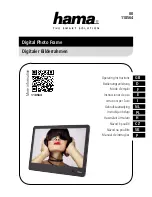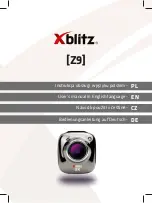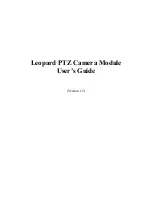
So, if you set distance of 1,5 m, and diaphragm of 2,8, all objects between 1,2m and 2 m from film plane will
be sharp. But if you change diaphragm value to 8, sharpness range will change to 0,9m up to 5m.
6.3. Cocking the shutter.
Advance a film rotating wind knob (3) clockwise until stop. Shutter will be cocked automatically during this
process.
6.4. Photographing.
Observing in the view finder (18), point the camera to desired object so that it was
placed inside luminous frames of the view finder. If the object is on distance closer
than 3m, you should determine frame borders by the parallactical marks inside a
luminous frame (fig. 9).
Release the shutter, smoothly pressing button (1).
6.5. Photographing with flashlight.
The camera has flash socket that allows to use electronic flashes with cable-free connection.
Take off insertion (6) and mount a flashlight into the hot shoe (5). Flash may be mounted or dismounted both
in cocked and released state of the shutter.
When using a flash, set a diaphragm value on the scale (12) in interval from 2,8 up to 16 only. Setting it to
position left of 2,8 is not recommended.
6.6. Unloading the camera.
6.6.1. If you using take-up spool, press the button (4) and adjust index with red point. Take out the rewind
crank (2) and rotate it in direction specified by an arrow to rewind used film into the cartridge. You will know
about film ending by weak jerk and easier rotation of the crank. Take off a camera cover (13) and take the
cartridge. The picture counter thus automatically will reset to reference mark.
6.6.2. If you using take-up cartridge to transport film “from cartridge to cartridge, than after shooting 72-nd
frame, shoot empty 2 frames, take off the cover (13) and take out the block of cartridges.
Cut off a film from feeding cartridge. Similarly, it is possible to take part of exposed film from the camera
if it is necessary, and load the rest again. The freed cartridge may be used at the subsequent camera loading
as a take-up cartridge.
7. RULES OF CARE AND STORAGE OF THE CAMERA
The camera requires care. It is necessary to keep it clean and preserve it from mechanical damages, dampness
and fast changing of temperature.
You must use a napkin or the cotton wool slightly moistened with spirit, and also the squirrel brush to cleaning
an optical surfaces of the lens and of the view finder.
Independent disassembling of the camera is prohibited, as it may lead to break adjustments of separate units.
Repair and adjusting may be made by the qualified experts in repair workshops only. Using of any greasing in
the camera is forbidden.
8. ACCEPTANCE CERTIFICATE
The camera “Agat-18K” factory number ________________ meets to specifications TU3-3.377-83 and is
recognized suitable for operation.
Date of manufacturing_____________________
The controller____________________________
(signature or stamp)
The packer______________________________
(signature or stamp)
Bordering frame of the
view finder
Figure 9
























